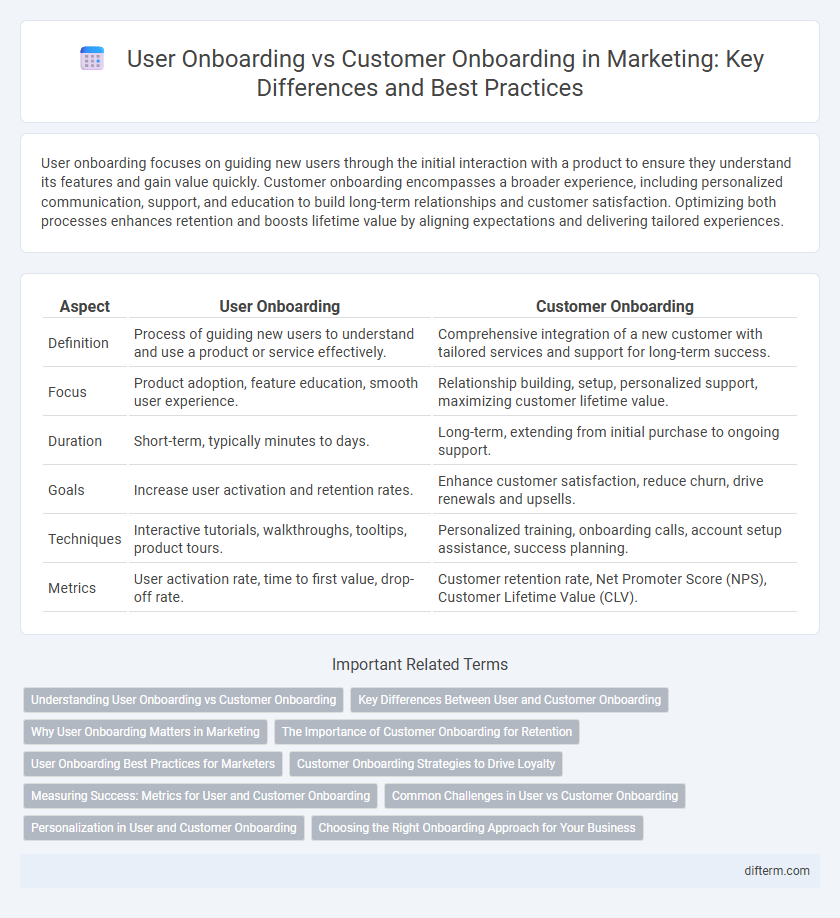User onboarding focuses on guiding new users through the initial interaction with a product to ensure they understand its features and gain value quickly. Customer onboarding encompasses a broader experience, including personalized communication, support, and education to build long-term relationships and customer satisfaction. Optimizing both processes enhances retention and boosts lifetime value by aligning expectations and delivering tailored experiences.
Table of Comparison
| Aspect | User Onboarding | Customer Onboarding |
|---|---|---|
| Definition | Process of guiding new users to understand and use a product or service effectively. | Comprehensive integration of a new customer with tailored services and support for long-term success. |
| Focus | Product adoption, feature education, smooth user experience. | Relationship building, setup, personalized support, maximizing customer lifetime value. |
| Duration | Short-term, typically minutes to days. | Long-term, extending from initial purchase to ongoing support. |
| Goals | Increase user activation and retention rates. | Enhance customer satisfaction, reduce churn, drive renewals and upsells. |
| Techniques | Interactive tutorials, walkthroughs, tooltips, product tours. | Personalized training, onboarding calls, account setup assistance, success planning. |
| Metrics | User activation rate, time to first value, drop-off rate. | Customer retention rate, Net Promoter Score (NPS), Customer Lifetime Value (CLV). |
Understanding User Onboarding vs Customer Onboarding
User onboarding focuses on guiding new users through the initial interaction with a product or service to ensure they understand its features and derive value quickly. Customer onboarding encompasses a broader process, including building long-term relationships, aligning expectations, and integrating the product into the customer's workflow. Understanding the distinction between user onboarding and customer onboarding improves targeted marketing strategies and enhances retention rates.
Key Differences Between User and Customer Onboarding
User onboarding focuses on guiding individuals through the product interface to ensure they can effectively use features, whereas customer onboarding emphasizes a broader relationship-building process including support, training, and integration with business needs. User onboarding typically involves in-app tutorials and tooltips designed to improve product adoption, while customer onboarding may include personalized consultations, account setup, and custom onboarding plans. These key differences highlight that user onboarding aims at product engagement, whereas customer onboarding targets overall customer success and retention.
Why User Onboarding Matters in Marketing
User onboarding focuses on guiding new users through the initial stages of product interaction to boost engagement and reduce churn, directly impacting marketing ROI. Effective user onboarding significantly increases lifetime value (LTV) by creating a seamless experience that encourages adoption and habit formation. Prioritizing user onboarding in marketing strategies enhances conversion rates and drives sustainable growth through improved user retention and satisfaction.
The Importance of Customer Onboarding for Retention
Customer onboarding is critical for retention as it ensures new users fully understand and engage with a product's value, reducing churn rates. Effective onboarding processes integrate personalized communication, clear guidance, and helpful resources to build trust and satisfaction from the outset. Prioritizing customer onboarding leads to higher lifetime value and stronger brand loyalty compared to generic user onboarding approaches.
User Onboarding Best Practices for Marketers
User onboarding focuses on guiding individuals through initial product interactions to maximize engagement and satisfaction, whereas customer onboarding encompasses broader post-purchase experience management. Effective user onboarding best practices for marketers include personalized in-app tutorials, segmented communication based on user behavior, and continuous feedback loops to refine the onboarding process. Leveraging data analytics to track user progress and implementing interactive elements significantly improve activation rates and long-term retention.
Customer Onboarding Strategies to Drive Loyalty
Customer onboarding strategies that emphasize personalized communication, clear product education, and proactive support significantly boost customer retention and loyalty. Implementing multi-channel onboarding experiences, including tutorials, webinars, and tailored follow-ups, enhances user engagement and satisfaction throughout the customer journey. Leveraging data analytics to monitor onboarding success allows marketers to refine processes, ensuring customers feel valued and confident with their purchase decisions.
Measuring Success: Metrics for User and Customer Onboarding
User onboarding success is measured through activation rates, time to first key action, and user retention within the initial onboarding period. Customer onboarding metrics emphasize customer satisfaction scores (CSAT), Net Promoter Score (NPS), and churn rates post-onboarding to evaluate long-term engagement and loyalty. Analyzing these distinct metrics helps tailor onboarding strategies, optimizing the user experience and maximizing revenue growth.
Common Challenges in User vs Customer Onboarding
User onboarding often struggles with engagement and intuitive design, causing drop-offs before users fully experience product value. Customer onboarding faces challenges in personalized communication and aligning diverse stakeholder expectations to ensure satisfaction and retention. Both processes require tailored strategies to address distinct pain points in usability and relationship management.
Personalization in User and Customer Onboarding
Personalization in user and customer onboarding enhances engagement by tailoring experiences based on behavior, preferences, and demographics. User onboarding focuses on guiding new users through product features with customized tutorials and in-app messages, while customer onboarding emphasizes building long-term relationships through personalized communication and support aligned with business goals. Leveraging data-driven personalization reduces churn rates and accelerates time-to-value for both users and customers, ultimately driving higher satisfaction and retention.
Choosing the Right Onboarding Approach for Your Business
User onboarding emphasizes guiding individual users through a product or service to ensure engagement and satisfaction, while customer onboarding addresses the broader process of integrating clients, often involving multiple stakeholders and higher-value relationships. Choosing the right onboarding approach depends on your business model, target audience, and product complexity; SaaS products often benefit from user onboarding, whereas B2B companies require comprehensive customer onboarding strategies. Tailoring your onboarding to these distinctions optimizes retention rates and accelerates time-to-value for both users and customers.
User onboarding vs customer onboarding Infographic

 difterm.com
difterm.com